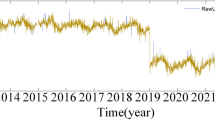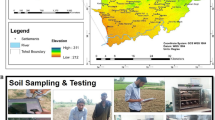Abstract
Spatial models to describe dependent georeferenced data are applied in different fields and, particularly, are used to analyze earth and environmental data. Most of these applications are carried out under Gaussian spatial models. The Birnbaum–Saunders distribution is a unimodal and positively skewed model which has received considerable attention in several areas, including earth and environmental sciences. In addition, theoretical arguments have been provided to justify its usage in the data modeling from these sciences, at least in the same settings where the lognormal distribution can be employed. This paper presents kriging with external drift based on a Birnbaum–Saunders spatial model. The maximum likelihood method is considered to estimate its parameters. The results obtained in the paper are illustrated by an experimental data set related to agricultural management. Specifically, in this illustration, the spatial variability of magnesium content in the soil as a function of calcium content is analyzed.





Similar content being viewed by others
References
Allard D, Naveau P (2007) A new spatial skew-normal random field model. Commun Stat Theor Methods 36:1821–1834
Assumpção RAB, Uribe-Opazo MA, Galea M (2014) Analysis of local influence in geostatistics using Student-t distribution. J Appl Stat 41:2323–2341
Bishop T, McBratney A (2001) A comparison of predictions methods for creation of the creation of field-extent soil property maps. Geoderma 103:149–160
Cambardella C, Moorman T, Novak J, Parkin T, Karlen D, Turco R, Konopka A (1994) Field-scale variability of soil properties in central Iowa soils. Soil Sci Soc Am J 58:1501–1511
Caro-Lopera F, Leiva V, Balakrishnan N (2012) Connection between the Hadamard and matrix products with an application to matrix-variate Birnbaum–Saunders distributions. J Multivar Anal 104:126–139
Chilès JP, Delfiner P (2012) Geostatistics: modeling spatial uncertainty. Wiley, New York
Cressie N (2015) Statistics for spatial data. Wiley, New York
De Bastiani F, Cysneiros AHMA, Uribe-Opazo MA, Galea M (2015) Influence diagnostics in elliptical spatial linear models. TEST 24:322–340
Diggle PJ, Ribeiro PJ (2007) Model-based geoestatistics. Springer, New York
Dunn P, Smyth G (1996) Randomized quantile residuals. J Comput Graph Stat 5:236–244
Ferreira M, Gomes MI, Leiva V (2012) On an extreme value version of the Birnbaum–Saunders distribution. REVSTAT Stat J 10:181–210
Garcia-Papani F, Uribe-Opazo MA, Leiva V, Aykroyd RG (2018) Birnbaum–Saunders spatial regression models: diagnostics and application to chemical data. Chemom Intell Lab Syst (in press)
Garcia-Papani F, Leiva V, Uribe-Opazo MA, Aykroyd RG (2017) Birnbaum–Saunders spatial modelling and diagnostics applied to agricultural engineering data. Stoch Environ Res Risk Assess 31:105–124
Goovaerts P (1997) Geostatistics for natural resources evaluation. Oxford University Press, Oxford
Hengl T, Heuvelink G, Stein A (2003) Comparison of kriging with external drift and regression-kriging. In: Technical report, International Institute for Geo-information Science and Earth Observation (ITC), Enschede, The Netherlands
Hengl T, Heuvelink G, Stein A (2004) A generic framework for spatial prediction of soil variables based on regression-kriging. Geoderma 120:75–93
Hu Y, Jia Z, Cheng J, Zhao Z, Chen F (2016) Spatial variability of soil arsenic and its association with soil nitrogen in intensive farming systems. J Soils Sedim 16:169–176
Johnson NL, Kotz S, Balakrishnan N (1994) Continuous univariate distributions, vol 1. Wiley, New York
Johnson NL, Kotz S, Balakrishnan N (1995) Continuous univariate distributions, vol 2. Wiley, New York
Journel AG (1980) The lognormal approach to predicting local distributions of selective mining unit grades. J Int Assoc Math Geol 12:285–303
Journel AG, Huijbregts CJ (1978) Mining geostatistics. Academic Press, New York
Lange K (2001) Numerical analysis for statisticians. Springer, New York
Leiva V (2016) The Birnbaum–Saunders distribution. Academic Press, New York
Leiva V, Athayde E, Azevedo C, Marchant C (2011) Modeling wind energy flux by a Birnbaum–Saunders distribution with unknown shift parameter. J Appl Stat 38:2819–2838
Leiva V, Ferreira M, Gomes MI, Lillo C (2016) Extreme value Birnbaum–Saunders regression models applied to environmental data. Stoch Environ Res Risk Assess 30:1045–1058
Leiva V, Marchant C, Ruggeri F, Saulo H (2015) A criterion for environmental assessment using Birnbaum–Saunders attribute control charts. Environmetrics 26:463–476
Leiva V, Sanhueza A, Angulo JM (2009) A length-biased version of the Birnbaum–Saunders distribution with application in water quality. Stoch Environ Res Risk Assess 23:299–307
Leiva V, Santos-Neto M, Cysneiros FJA, Barros M (2014) Birnbaum–Saunders statistical modelling: a new approach. Stat Modell 14:21–48
Leiva V, Saulo H (2017) Environmental applications based on Birnbaum–Saunders models. In: Adhikari A, Adhikari MR, Chaubey YP (eds) Mathematical and statistical applications in life sciences and engineering. Springer, Singapore, pp 283–304
Lillo C, Leiva V, Nicolis O, Aykroyd RG (2018) L-moments of the Birnbaum–Saunders distribution and its extreme value version: estimation, goodness of fit and application to earthquake data. J Appl Stat 45:187–209
Lopes AS (1998) International soil fertility manual. Potafos, Piracicaba (in Portuguese)
Marchant C, Leiva V, Cavieres MF, Sanhueza A (2013) Air contaminant statistical distributions with application to PM10 in Santiago, Chile. Rev Environ Contam Toxicol 223:1–31
Marchant C, Leiva V, Cysneiros FJA (2016a) A multivariate log-linear model for Birnbaum–Saunders distributions. IEEE Trans Reliab 65:816–827
Marchant C, Leiva V, Cysneiros FJA, Liu S (2018) Robust multivariate control charts based on Birnbaum–Saunders distributions. J Stat Comput Simul 88:182–202
Marchant C, Leiva V, Cysneiros FJA, Vivanco JF (2016b) Diagnostics in multivariate generalized Birnbaum–Saunders regression models. J Appl Stat 43:2829–2849
Mardia K, Marshall R (1984) Maximum likelihood estimation of models for residual covariance in spatial regression. Biometrika 71:135–146
Nocedal J, Wright S (1999) Numerical optimization. Springer, New York
Pan J, Fei Y, Foster P (2014) Case-deletion diagnostics for linear mixed models. Technometrics 56:269–281
Pawlowsky-Glahn V, Egozcue JJ (2016) Spatial analysis of compositional data: a historical review. J Geochem Explor 164:28–32
Pawlowsky-Glahn V, Egozcue JJ, Tolosana-Delgado R (2015) Modeling and analysis of compositional data. Wiley, New York
Podlaski R (2008) Characterization of diameter distribution data in near-natural forests using the Birnbaum–Saunders distribution. Can J For Res 18:518–527
R Core Team (2016) R: a language and environment for statistical computing. R Foundation for Statistical Computing, Vienna, Austria
Rendu JM (1979) Normal and lognormal estimation. Math Geol 11:407–422
Rimstad K, Omre H (2014) Skew-Gaussian random fields. Spat Stat 10:43–62
Santana L, Vilca F, Leiva V (2011) Influence analysis in skew-Birnbaum–Saunders regression models and applications. J Appl Stat 38:1633–1649
Saulo H, Leiva V, Ziegelmann FA, Marchant C (2013) A nonparametric method for estimating asymmetric densities based on skewed Birnbaum–Saunders distributions applied to environmental data. Stoch Environ Res Risk Assess 27:1479–1491
Severini TA (2000) Likelihood methods in statistics. Oxford University Press, Oxford
Soares A (2000) Geostatistics for earth and environmental sciences. IST Press, Lisboa (in Portuguese)
Tolosana-Delgado R, Pawlowsky-Glahn V (2007) Kriging regionalized positive variables revisited: sample space and scale considerations. Math Geol 39:529–558
Uribe-Opazo MA, Borssoi JA, Galea M (2012) Influence diagnostics in Gaussian spatial linear models. J Appl Stat 39:615–630
Vilca F, Sanhueza A, Leiva V, Christakos G (2010) An extended Birnbaum–Saunders model and its application in the study of environmental quality in Santiago, Chile. Stoch Environ Res Risk Assess 24:771–782
Webster R, Oliver M (2009) Geostatistics for environmental scientists. Wiley, Chichester
Wolter KM (2007) Introduction to variance estimation. Springer, New York
Xia J, Zeephongsekul P, Packer D (2011) Spatial and temporal modelling of tourist movements using semi-Markov processes. Tour Manag 51:844–851
Zhang H, Zimmerman DL (2005) Towards reconciling two asymptotic frameworks in spatial statistics. Biometrika 92:921–936
Acknowledgements
The authors thank the Editors and referees for their constructive comments on an earlier version of this manuscript which resulted in this improved version. This research work was partially supported by CNPq and CAPES grants from the Brazilian government, and by FONDECYT 1160868 grant from the Chilean government.
Author information
Authors and Affiliations
Corresponding author
Appendix: multivariate BS and log-BS distributions
Appendix: multivariate BS and log-BS distributions
A continuous random variable \(T_i > 0\) has a BS distribution with shape (\(\alpha _i>0\)) and scale (\(\varrho _i >0\)) parameters, denoted by \(T_i \sim \text{BS}(\alpha_i, \varrho_i)\), for \(i = 1, \ldots ,n\), if (see details in Leiva 2016, pp. 18–20)
such that
Let the random vector \(\underline{T} = (T_1,\ldots ,T_n)^\top \in {\mathbb {R}}^{n}_{+}\) have a BS\(_n\) distribution, with shape vector \(\underline{\alpha } = (\alpha _1, \ldots , \alpha _n)^\top \in {\mathbb {R}}^{n}_{+}\), scale vector \(\underline{\varrho }=(\varrho _1,\ldots ,\varrho _n)^\top \in {\mathbb {R}}^{n}_{+}\), and association matrix \({\varvec{{\varSigma }}} \in {\mathbb {R}}^{n\times n}_{+}\), with \(\text{rk}({\varvec{{\varSigma}}}) = n\) and \(\text{rk}({\varvec{{\varSigma}}})\) being the rank of the matrix \({\varvec{{\varSigma }}}\). This is denoted by
Note that \({\varvec{{\varSigma }}} = (\sigma _{ij})\) is the \(n\times n\) variance-covariance matrix of the random vector \(\underline{Z} = (Z_1, \ldots, Z_n)^\top \sim \text{N}_n(\underline{0}_{n\times 1}, {\varvec{{\varSigma}}})\), with \(\sigma _{ij} = 1\), if \(i=j\), whereas \(\sigma_{ij} = \text{Cor}(Z_i, Z_j)\), if \(i\ne j\), that is, the coefficient of correlation between \(Z_i\) and \(Z_j\) as given in (16), for \(i,j=1,\ldots ,n\). Thus, if \(\underline{T} \sim \text{BS}_n(\underline{\alpha}, \underline{\varrho}, {\varvec{{\varSigma}}})\), then its probability density function is given by
with \(\underline{t} \in {\mathbb {R}}^{n}_{+}\), where \(\phi _n\) is the n-variate N(0, 1) probability density function. If \(\underline{T} \sim {{\text {BS}}_n}(\underline{\alpha }, \underline{\varrho }, {\varvec{{\varSigma }}})\), properties hold:
(i) For \(i,\,j=1,\ldots ,n\), we have
(ii) For the partitions
where \(\underline{T_1}, \underline{\alpha }_1,\underline{\varrho }_1\) are \(q\times 1\) vectors, \(\underline{T_2}, \underline{\alpha }_2,\underline{\varrho }_2\) are \(p\times 1\) vectors, \({\varvec{{\varSigma }_{11}}}\) is an \(n_1\times n_1\) matrix, \({\varvec{{\varSigma }_{22}}}\) is an \(n_2\times n_2\) matrix, and \({\varvec{{\varSigma }_{12}}}={\varvec{{\varSigma }_{21}}}^\top\) is an \(n_1\times n_2\) matrix, with \(n_1+n_2=n\); then, \(\underline{T}_l \sim \text{BS}_{n_l}(\underline{\alpha }_l,\underline{\varrho}_l; {\varvec{{\varSigma}}}_{ll})\), for \(l=1,2\);
(iii) If \(c>0\), then \(c\underline{T} \sim \text{BS}_n(\underline{\alpha}, c\underline{\varrho};{\varvec{{\varSigma}}})\) and
whereas an analogous property applies to \(c \underline{T_2}\); and (iv) Considering the notation \(\underline{A}^{-1} = (1/A_i)\), where \(\underline{A} =(A_i)\) is a vector and \(A_i\) its elements, then
and
with
which applies analogously to \(\underline{T_2}^{-1}\). Let
\(Y_i = \log (T_i)\) and \(\mu _i = \log (\varrho _i)\), for \(i=1,\ldots ,n\), with \(-\,\infty< Y_i < +\,\infty\) and \(-\,\infty<\mu _i < +\,\infty\). Then, the random vector \(\underline{Y}=(Y_1,\ldots ,Y_n)^\top\) has a log-BS\(_n\) distribution, with shape and location vectors, respectively,
and association matrix \({\varvec{{\varSigma }}}\) as given in (17). This is denoted by \(\underline{Y} \sim \text{log-BS}_n(\underline{\alpha}, \underline{\mu}, {\varvec{{\varSigma}}})\) and its probability density function is defined as
where \(\phi _n\) is given in (17). Let \(\underline{Y} \sim \text{log-BS}_n(\underline{\alpha}, \underline{\mu}, {\varvec{{\varSigma}}})\). Thus, the following properties hold:
-
(i)
\(Y_i \sim \text{log-BS}(\alpha_i,\mu_i)\) , for \(i=1,\ldots ,n\);
-
(ii)
If \(\underline{a}=(a_1,\ldots ,a_n)^\top\) is a constant vector, \(\underline{Y}+\underline{a}\sim \text{log-BS}_n(\underline{\alpha}, \underline{\mu} + \underline{a}; {\varvec{{\varSigma}}})\);
-
(iii)
\(\text{E}(\underline{Y}) = \underline{\mu}\);
-
(iv)
If \(\underline{\alpha }=\alpha \underline{1}_{n\times 1}^\top\) and \(\underline{\mu }=\underline{0}_{n\times 1}\), then \(\text{Cov}(\underline{Y}) \approx \alpha^2{\varvec{{\varSigma}}}\);
-
(v)
If \(\underline{Y} \sim \text{log-BS}_n(\alpha \underline{1}_{n\times 1}, \underline{\mu}; {\varvec{{\varSigma}}})\), then
$$\begin{aligned} \frac{4}{\alpha ^2}\underline{V}^\top {\varvec{{\varSigma }}}^{-1}\underline{V} \end{aligned}$$has a \(\chi ^2\) distribution with n degrees of freedom, where \(\underline{V}= (V_1,\ldots ,V_n)^\top\), with
$$\begin{aligned} V_i=\sinh \left( \frac{y_i-\underline{x}_i^\top {\underline{\varrho }}}{2}\right) ,\quad i=1,\ldots ,n. \end{aligned}$$
Rights and permissions
About this article
Cite this article
Garcia-Papani, F., Leiva, V., Ruggeri, F. et al. Kriging with external drift in a Birnbaum–Saunders geostatistical model. Stoch Environ Res Risk Assess 32, 1517–1530 (2018). https://doi.org/10.1007/s00477-018-1546-9
Published:
Issue Date:
DOI: https://doi.org/10.1007/s00477-018-1546-9




